The magic of a moving glacier is mesmerising. It's one of the main reasons people venture onto the small island of Iceland. 11% of the country is covered in ice, which accounts for a dozen icecaps and around 400 glaciers.
Many sit on top of volcanoes, perched inside the calderas waiting to spill over the edge. In fact, high up volcanic craters are a great places for glaciers to form. They are cold enough for snow to fall and not melt, due to their altitude (assuming they aren't actually erupting at the time) - and a good environment to catch snow and protect it from wind and direct sunlight.
Glaciers often come hand in hand with volcanoes, it seems, in this isolated region of the world. Hence the nickname, the Land of Fire and Ice.
Below details everything you need to know to understand how a glacier is formed. A journey that begins with one tiny snowflake, and over the centuries turns into a mighty glacier.
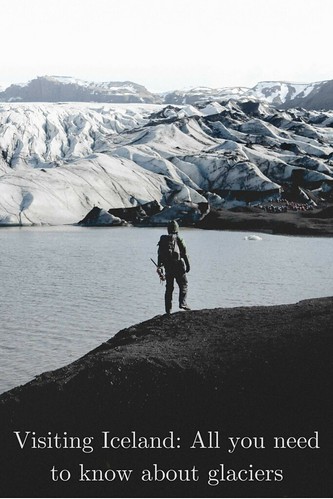
Hike to Solheimajökull Glacier - Norris Niman, adapted by Wandering Educators
The beginning - Pre-snowflake
A snowflake takes only minutes to form. The resulting glacier can take over 100 years to form.
The beginning of a snowflake is simple. A tiny speck in the air (maybe dust or pollen) encounters water vapor that has risen from the warm air below.
As the temperature drops, the water vapor in the air clings on to this speck and freezes around it, creating an ice crystal.
The speck begins to gain weight as more water vapor freezes around it and allows the ice crystal to grow. Depending on a multitude of factors, this whole process can take just minutes to happens.
Once it gains sufficient weight, the snowflake begins to fall. Since ice is actually less dense than water, the snowflake needs to grow substantially before it begins to fall (substantial in the sense that it becomes visible to the naked eye).
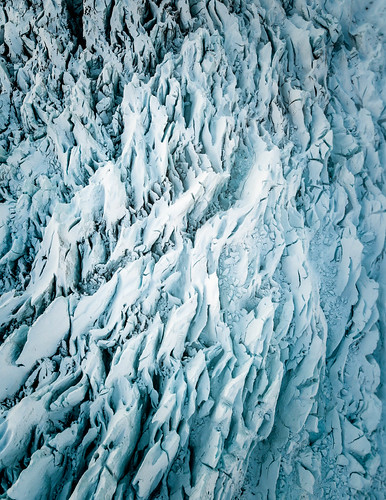
Falljökull Glacier aerial - Jonny Livorti
A Falling Snowflake
Snow is incredible. It is so light and filled with air between each individual crystal that it is far less dense than ice or water. On average, it is 20 times less dense than water.
Fresh snow is 50kg per cubic meter to be exact. Water is 1000kg/m3.
All snowflakes are six sided, and no two snowflakes have ever been found to be identical. This is because as snowflakes fall, they continue to expand and stretch in a hexagonal shape by freezing more and more water vapor around it.
Each snowflake falls in a slightly different way, so grows slightly differently. As they encounter water molecules in the air, they will bond and freeze along the rough edges (the most sticky parts). The colder it gets the more the ice stretches and collects more water to grow.
Even as it grows in size, it only slowly drops to the ground, at around 2 miles per hour on average. Depending on winds and the height of the initial cloud, it can take around 30 mins to hit the ground. For comparison, a person jumping out of a plane at the same height would take less than 2 minutes.
Snowflake touchdown
Once the snowflake hits the ground, assuming the increased temperature hasn't melted it back into water (rain), it will happily sit on the cold ground (or in this case ice) and continue what it has been doing since birth: growing. It continues to stretch and continues to collect water vapor and freeze. As this happens, more and more air gets pushed out from the empty gaps, making it slightly more dense. In an Icelandic winter or deep into an ice cave, these individual ice crystals grow large enough to see every groove and shape.
Snowfall
Usually a snowflake is not alone, and during a particularly powerful storm in Iceland, up to 55cm of snow can fall overnight. Despite how light snow is, it is also very fragile. This means that as more snow falls, the first layer will quickly compact down under its own weight and squeeze out trapped air.
With only 3 metres of depth, this squeezed snow can be up to 200kg per cubic meter (started as 50), though still only around a fifth of the density of water.
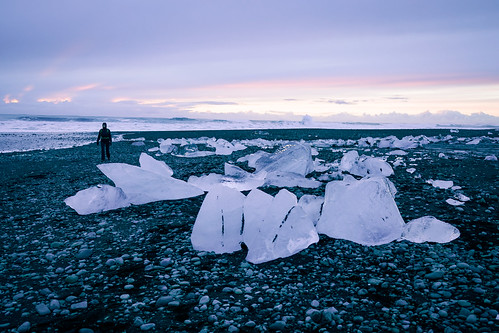
Diamond beach (Jökulsárlón) - Scott Drummond
Melt or Freeze
To truly begin the glaciation process, the snowflake needs to go through an entire summer without melting. No easy task, even in Iceland. If it survives to the following winter, the exciting stuff begins.
The snow can be destroyed in a few different ways: rain, erosion, sublimation, heat, or wind. So even if it is freezing all year round, like up in the mountains or on mainland Antarctica, it doesn't guarantee glaciation. It's referred to as ablation.
In the last few years, as global temperatures have risen, most glaciers in Iceland that are close to sea level will not retain any fresh snow for following year. This, in effect, means that the existing glaciers will not grow due to snowfall ever again in that area.
But higher up in the ice caps, such as the Vatnajökull, the largest ice cap by volume in Europe, the glaciation process is still in full swing and continues to force fresh ice down the mountainside.

Jökulsárlón Northern Lights - Tom Archer
Compressed Snow - Neve
Next up is Neve. This is when the ice crystals have grown substantially and enough air has been squeezed out that it is approaching ice. It is grainy in texture, but often still maintains some of the snowflakes' original shape. Neve occurs over a winter, depending on how much freezing and thawing occurs.
It's around a third to half as dense as water at 350-500kg/m3
Pre-ice - Firn
This stage often gets mistaken for ice, and is an integral part of a glacier. Many sections of a glacier will have sections of firn that is old and dense, but hasn't been squeezed for sufficient enough time to become glacier ice. It is the final stage before becoming beautiful blue glacier ice.
It can form as quickly as one to two years, but often will have substantial amounts of snowfall on top of it to aid in the compression.
This stage is between 550kg/m3 and 800kg/m3.
Blue Glacier Ice
By this point, most of the air is pushed out of the resulting ice, and any air pockets will either be isolated bubbles or so tiny they can't be seen anymore. Despite the fact that the previous processes can occur in as little as two years, the final compression can take over 100 years and typically includes at least 100 metres of snowfall to reach the required pressures. Glaciers like Falljökull, in the Vatnajökull National Park, have a very short life cycle of between 700 and 900 years.
The ice crystals have also continued to grow and can reach several inches in length. It's at this point that the ice will appear blue and be at its maximum density.
The reason ice is blue requires a longer explanation, but the short version is that due to the density of the ice and the structure of the water molecules in ice, the majority of light in the visible light spectrum will enter the ice (as opposed to bouncing off like with snow or other material), vibrate and interact with the molecules, and be absorbed. It's only the blue end of the wavelength spectrum that emanates out, creating a blue 'overtone'.
Glacier ice can range from 850kg/m3 up to a maximum density of 917kg/m3. Note that this is still less dense than water, which is 1000kg/m3.
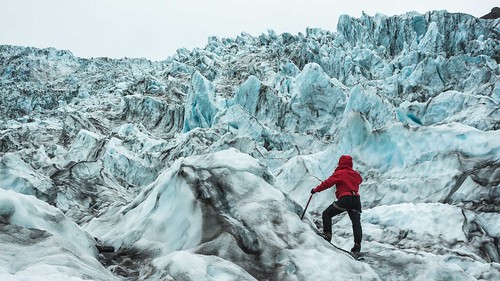
Falljökull Ice Fall- Norris Niman
The glacier begins to move
Now that the glacier has been formed, it is big enough and strong enough to move under its own weight. They can move as slowly as a few centimetres a year, up to 10 metres a day in some cases. In Iceland, this varies, but up to 1 foot per day is generally the norm. If a glacier is lucky enough to push all the way to the sea before melting completely, erosion and melting will start to break off chunks from the terminal face, known as calving. This is particularly well observed at the Jökulsárlón glacier lagoon, which is both partially landlocked and affected by strong sea currents through a narrow outlet. In these types of areas, icebergs the size of multi-story houses can be seen floating and spinning in their beautiful blue state before they are destroyed or melted.
This is the beginning of the end for the glacier. This is the start of icebergs.
Icebergs
An iceberg is simply glacial ice that's broken off the front of a glacier into water (calving). And if you recall, glacier ice is less dense than water, which means that an iceberg, regardless of size, will float.
About 80-90% of the ice will be submerged under water, and is around 69 times less reflective in radar than a ship. This means that icebergs, even in today's high tech era, are still a formidable threat to ships, not just the Titanic.
The average iceberg (of 200k tonnes) is around 100 trillion snowflakes.
The whole process of snowflake to glacier to iceberg can take hundreds or thousands of years. In fact, some of the ice in Antarctica is millions of years old.
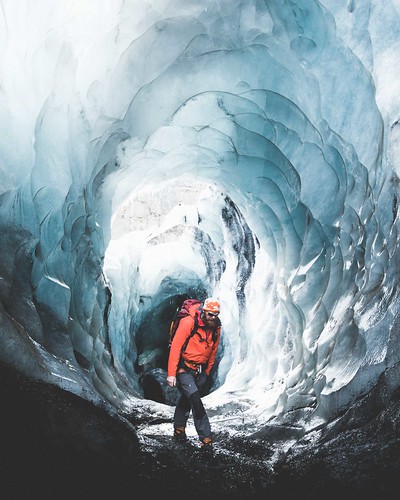
Solheimajökull Glacier - Norris Niman
The end
So after an iceberg sinks a few ships, it will eventually float into warmer waters and melt. This can take decades in the right conditions. As it fully melts, it rejoins the ocean.
Then in the right circumstances, the entire process begins again. Ironically, snow can't be formed without a little heat.
As soon as the temperature rises and some of the sea water evaporates and rises into the air, if it's the right conditions, that water vapor can grab onto a tiny speck of pollen or dust and freeze as the temperature drops....I think you see where this is going.
Snowflake to glacier to iceberg to snowflake.
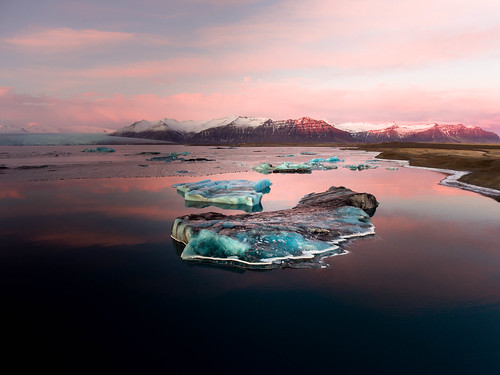
Jökulsárlón sunset - Jonny Livorti
Ryan Connolly is a glacier guide and co-founder of an immersive travel company called Hidden Iceland (www.hiddeniceland.is). They specialise in taking small groups on educational and family friendly trips. He has walked on all 7 continents and guides on multiple glaciers across Iceland with his company. His practical and working knowledge of glaciers and their movement allows him to understand the dangers and trends in ice flow in his adopted country. This is particularly important when guiding families in ever changing places like on glaciers.
Find him online:
Facebook, Instagram, and LinkedIn
All photos used with permission
